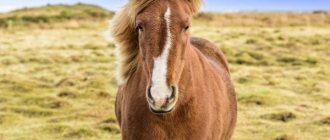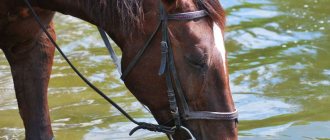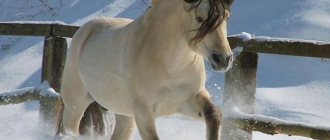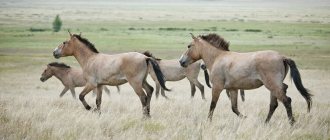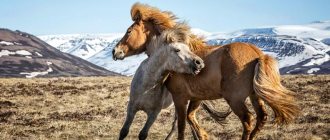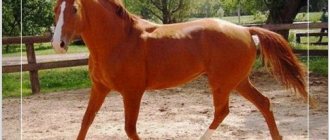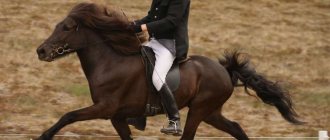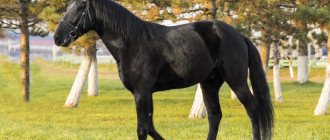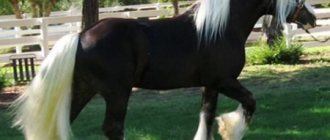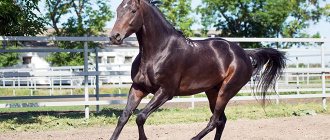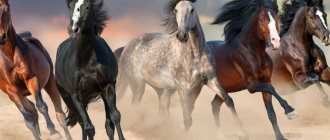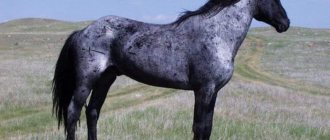History of feral horses
America is considered to be the original place where the horse appeared. It was on the prairies that the ancestors of modern horses originated millions of years ago. They were significantly inferior in height, had several fingers and lived mainly along rivers and water bodies. But as the climate changed and the area of the steppes increased, equines changed. This led to their adaptation to an active nomadic lifestyle, which facilitated settlement. Thus, as a result of one migration, horses entered the territory of Eurasia through the Bering Strait, which at that time was connected by an isthmus.
But later horses completely died out in America. Whether this was the influence of humans or climatic factors is not known. The only known fact is that the indigenous population did not have horses, and the meeting with these animals was unexpected for them. The only species of wild horses today is the Przewalski's horse, which lives in the Mongolian steppes.
The horses are coming again
During his second voyage, Columbus imported a small number of horses from Spain. But the beginning of horse breeding in the New World is associated with the name of Cortez, who in 1519 and 1525 brought a large number of horses and formed a breeding core in Mexico. Most of the imported horses were Spanish (Andalusian) horses, but there were also plenty of other breeds, the number and diversity of which increased over the years, allowing the formation of a phenotypically distinct group of mustangs.
Mustangs are semi-wild horses that returned to their natural existence after they were brought to America by settlers from Europe.
By the end of the 16th century, the number of horses grew rapidly, in Florida alone the number of heads exceeded 1000. The local population played a significant role in the development of horse breeding - the Indians quickly adopted the horse as the main means of transportation, although many simply hunted them for food. The use of horses for meat was practiced by Indians who were not familiar with European culture. But most of the indigenous population was captured and used for housework. Although Spanish legislation of those years prohibited teaching Indians how to ride horses, many settlers violated this ban in order to increase the efficiency of slavery. As a result, fugitive Indians trained in horse riding could teach their fellow tribesmen.
From heyday to decline
Many Indians began to actively use horses, which were stolen or bought in large numbers (it is known that the Apache and Navaja tribes bought over 2,000 horses from the Spaniards at the end of the 17th century). The indigenous population also showed itself in breeding work; for example, they bred the first American breed - the Appaloosa, which has been known since 1750.
At the same time, the importation of horses from the territory of the Old World continues. Thus, in 1769, Spanish settlers created a settlement in California, the number of horses in which exceeded 24,000 heads. The population grew so quickly that a significant part simply scattered around the area, and even more were simply killed for meat.
The number of horses increased rapidly. By the beginning of the 19th century, the number of semi-wild animals, according to various estimates, was 2-6 million individuals. At the same time, it is impossible to judge the exact number of animals, since no attempts were made to count them before 1971 (the law on counting wild and stray donkeys and horses was issued). According to other sources, the population peaked at the beginning of the wars between America and Mexico (in 1848) and Spain (in 1898). During these events and after, the number sharply declined. Firstly, due to the capture of horses for the needs of the army, and secondly, due to the subsequent shooting of horses that harmed agriculture.
The 20th century saw a rapid decline in the number of wild horses in America. In 1930, most of the population lived west of the continental divide and did not exceed 100 thousand. But by 1950 the population had dropped to 25 thousand. Feral animals were crowded out by farmers, captured by cowboys, and shot from airplanes. Cases of poisoning of watering places have been repeatedly identified . All this contributed to the introduction of the Mustang Protection Act in 1959. According to it, hunting of animals was limited and bans on farming were introduced. At the same time, forest services were introduced and national parks were opened.
According to the results of the 2010 census, the total number of wild horses was 34 thousand individuals and about 5,000 donkeys. Most of the animals are concentrated in Nevada, with significant populations still found in California, Oregon and Utah.
What is Pony Express?
As the North American West was settled, it became clear how much the inhabitants there needed reliable communications with the cities of the east coast. During snowfall and bad weather, roads, especially in mountainous areas, became almost impassable. In order to maintain regular communication, a company was founded in 1860, which became known as the Pony Express. Its purpose was the urgent delivery of important messages and documents from St. Joseph on the banks of the Missouri to Sacramento in California. The founder of Pony Express was. The company purchased five thousand hardy and playful Indian ponies and hired 80 strong, but not too tall couriers. After 10–15 miles along the entire road, postal stations were equipped, where a blacksmith and two replacement couriers were constantly on duty. Several ponies were also kept at the ready, one of which was even saddled. As soon as the sound of the horn of an approaching courier was heard in the distance, the attendants with a saddled horse came out to meet him, with the utmost speed they removed the mail bags from the tired horse and attached the fresh one to the saddle. And the courier is on the way! The whole procedure took no more than two and a half minutes. If the courier had already fulfilled his quota, having covered four stages without rest, the route was continued by a replacement. The norm was later increased to eight stations.
Characteristics of feral horses
The main population of mustangs lives in the arid regions of the United States, where farmers squeezed them out. These are regions unsuitable for raising livestock, where it is difficult to obtain good feed and water. Therefore, there is a gradual degeneration of animals, which has been observed throughout the history of the existence of mustangs.
They are considered to be beautiful and graceful animals, similar to the best Eastern and European horses. But this is just an image formed by writers and cinema. In fact, mustangs have never been bred and are the product of crossing a huge number of breeds. In addition, the European colonialists brought far from the best horses, and as a result of their uncontrolled mating, the type degenerated.
Currently, the American Horse Breeding Association has developed a breed standard, which includes the most characteristic animals with certain morphological features:
- slender body;
- dry head with a wide frontal lobe;
- small muzzle;
- straight head profile;
- moderate height at withers – 140-150 cm;
- the shoulder blade is long, located at an angle;
- the back is short;
- the chest is large;
- well developed muscles;
- round croup;
- low tail set;
- straight dry limbs;
- round hooves covered with dense horn.
The color of the mustangs does not matter much. Among these animals you can find individuals of any color - from black to white, but most often there are bay and brown animals with a large number of bizarrely shaped markings. The number of spotted animals among mustangs prevails over any other breed. This is due to the importation by the Spaniards of horses with markings and the love of the Indians for this coloring. Therefore, there are currently several breeds in America in which the main requirement is the presence of spotting. The diversity of marks and measurements is supported by differences in populations - several subphyla live in the United States, separated by terrain.
Links[edit]
- Vialkely, MK (June 2008). "Can you hear the bell?" (PDF). US Equestrian Federation. paragraph 51. Retrieved May 18, 2015.
- "Guide to USEF Interscholastic Riding Programs" (PDF). US Equestrian Federation. clause 1. Retrieved May 18, 2015.
- "Industry and Media Influence". theequestrianchannel.com
. Archived from the original on February 15, 2015. Retrieved May 19, 2015. - "Statistics of Herd Area and Herd Management Area" (PDF). US Geological Survey. Retrieved June 20, 2022.
- Macfadden, B. J. (1976). "A cladistic analysis of primitive equids with remarks on other perissodactyls". Syst. Zool
.
25
(1): 1–14. DOI: 10.2307/2412774. JSTOR 2412774. - McDonald, G. (March 1993). "Hagerman 'Horse' - Equus simplicidens". The Fossil Record
. Archived from the original on January 3, 2007. - ^ ab Azzaroli, A. (1992). "The Rise and Decline of Monodactyl Artiodactyls: A Case of Prehistoric Mass Extinction" (PDF). Anna. Zool. Finnici
.
28
: 151–163. - ^ab Weinstock, J.; and others. (2005). "Evolution, systematics and phylogeography of Pleistocene horses in the New World: a molecular perspective". PLOS Biology
.
3
(8):e241. DOI: 10.1371/journal.pbio.0030241. PMC 1159165. PMID 15974804. - ^ ab Orlando, L.; and others. (2008). "Ancient DNA Clarifies the Evolutionary History of Late Pleistocene American Horses." Journal of Molecular Evolution
.
66
(5):533–538. Bibcode: 2008JMolE..66..533O. DOI: 10.1007/s00239-008-9100's. PMID 18398561. S2CID 19069554. - Heintzman, Peter D; Zazula, Grant D; MacPhee, Ross DE; Scott, Eric; Cahill, James A; McHorse, Brianna K.; Kapp, Joshua D.; Stiller, Matthias; Wooller, Matthew J; Orlando, Louis; Southon, John (28 November 2022). "A new genus of horses from Pleistocene North America". eLife
.
6
: e29944. DOI: 10.7554/eLife.29944. ISSN 2050-084X. PMC 5705217. PMID 29182148. - ↑
Singer, Ben (May 2005). A Brief History of the Horse in America. Canadian Geographical Journal. Archived from the original on August 19, 2014. Retrieved October 16, 2009. - Henderson, Claire (1991). North American Aboriginal horse. Protect Mustangs
(Report). Retrieved February 26, 2022. - LeQuire, Elise (4 January 2004). "No grass, no horse". Horse, online edition. Retrieved June 8, 2009.
- Jump up
↑ Guthrie, R.D. (November 13, 2003).
"Rapid decline in body size in Pleistocene Alaskan horses before extinction." Nature
.
426
(6963): 169–171. Bibcode: 2003Natur.426..169D. DOI: 10.1038/nature02098. PMID 14614503. S2CID 186242574. - Zimov, S.A.; Chuprynin V.I.; Oreshko A.P.; Chapin F.S. Reynolds, J.F.; Chapin, M. C. (November 1995). "The steppe-tundra transition: a herbivore-driven biome shift at the end of the Pleistocene." American naturalist
.
146
(5):765–794. DOI: 10.1086/285824. JSTOR 2462990. S2CID 60439469. - "Ice Age horses may have been killed by humans". National Geographic News
. May 1, 2006 - ^ab Buck, Caitlin E.; Bard, Edward (2007). "Calendar chronology of Pleistocene extinctions of mammoths and horses in North America based on Bayesian radiocarbon calibration". Quaternary Scientific Reviews
.
26
(17–18): 2031. Bibcode: 2007QSRv ... 26.2031B. DOI: 10.1016/j.quascirev.2007.06.013. - Solow, Andrew; Roberts, David; Robbirt, Karen (9 May 2006). Haynes, K. Vance (ed.). "On the Pleistocene extinctions of Alaskan mammoths and horses". Proceedings of the National Academy of Sciences of the United States of America
(19th ed.).
103
(19):7351–3. Bibcode: 2006PNAS..103.7351S. DOI: 10.1073/pnas.0509480103. PMC 1464344. PMID 16651534. - Jump up
↑ Guthrie, R.D. (May 11, 2006).
"New Carbon Dates Link Climate Change to Human Colonization and Pleistocene Extinction." Nature
.
441
(7090):207–209. Bibcode: 2006Natur.441..207D. DOI: 10.1038/nature04604. PMID 16688174. S2CID 4327783. - Louis, Christina; and others. (2006). "Iberian Origins of New World Horse Breeds". Journal of Heredity
.
97
(2):107–113. DOI: 10.1093/jhered/esj020. PMID 16489143. - ^ab Rith (PDF). Retrieved January 18, 2015.
- "Colonial Spanish Horse". Livestock protection
. Retrieved May 19, 2015. - "Conservation Priority List - Horses". Livestock protection
. Retrieved May 19, 2015. - "Myths and Facts about Wild Horses and Burros". www.awionline.org
. - ^ ab Adams, Christina (December 19, 2014). "Horses in History - Introduction - A Horse is a Horse". USDA National Agricultural Library
. Archived from the original on April 30, 2015. Retrieved May 19, 2015. - "History of Horse Racing". Horseracing-hq.com. Retrieved April 8, 2014.
- ^ ab Haynes, Francis (January 1938). “Where did the Plains Indians get their horses?” . American anthropologist
.
40
(1): 112–117. DOI: 10.1525/aa.1938.40.1.02a00110. Retrieved May 19, 2015. - Quammen, David (March 2014). "People of the Horse". National Geographic
. Retrieved May 19, 2015. - "The Power of the Plains". American Museum of Natural History
. Retrieved May 19, 2015. - "Out of range" . American Museum of Natural History
. Retrieved May 19, 2015. - "In the city" . American Museum of Natural History
. Retrieved May 19, 2015. - "New in Racing: The Story of the Standardbred". Standardbred Canada. 2014. Retrieved June 27, 2014.
- "Falling horse production." 1926 Agricultural Yearbook
. USDA. pp. 437–439. Missing or empty |url=(help) - ^ a b "Rest: Return of the Horse". Time
. May 17, 1968. Retrieved May 19, 2015. - Industry, USA. Animal Bureau (1912). Report of the Chief of the Bureau of Animal Industry, USDA. US Government Printing Office. paragraph 106.
- Derry, Margaret (2006). Horses in Society: A History of Animal Husbandry and Marketing, 1800–1920. University of Toronto Press. item 131. ISBN. 9780802091123.
- "More horses sent overseas for slaughter after US ban". USATODAY.com. 2008
- “The West is on the brink of a wild horse apocalypse. (No, really.) - The Washington Post." August 26, 2013
- "Ocracoke Ponies: The Wild Bankers of Ocracoke Island". National Park Service: Cape Hatteras National Seashore
. US Department of the Interior, National Park Service. November 7, 2003 archiving from the original on December 11, 2008. Retrieved November 11, 2008. - "Wildlife on Cumberland Island". Wild Cumberland
. Retrieved March 31, 2012. - "Wild Horses of Assateague". nps.gov
. Retrieved June 10, 2010. - Dutson, Judith (2005). Storey's Illustrated Guide to the 96 Horse Breeds of North America
. Storey Publishing. pp. 217–219. ISBN 978-1580176132.
Colors of the Clydesdale breed
The animals are most often bay in color, although they can also be black, gray or chestnut. Their coat may be a solid color or have several roan markings or spots. White stockings on the legs are common, but solid colored horses are also found. They often have broad white patches or markings on their faces, resulting in eye-catching combinations.
Clydesdales often receive a premium, especially when they sport white muzzle markings and the familiar white stockings. Roans are generally the least preferred, but breed associations do not make that distinction. In their opinion, no color is undesirable, and they readily accept horses with spots on their bodies.
Enemies
The most dangerous predators for mustangs include the wolf and the puma. These animals are big enough to kill a horse. Most often they attack foals, old and sick individuals, thereby freeing the herds from the weakest representatives. Coyotes and foxes pose less of a threat to these creatures. These predatory animals attack only recently born foals left without the care of their mothers.
However, the most formidable enemy of mustangs is people. Hunting for these ungulates was widespread in the 19th and early 20th centuries, which almost led to the complete extinction of the population. Now this type of horse is protected by law.
Standardbred
This American horse breed was developed in the 19th century and is used in sports. Horses of Dutch, English, Norfolk and other breeds were used to create it. In 1870, a stud book was established. To qualify, a Standardbred had to run a mile in 2.30 minutes. selection took place only for agility, so the exterior is not very even, on average height is 155-160 cm, black color predominates, there are red and bay horses.
Standardbred
Quarter Horse
Also called the Quarter Mile, the breed was bred specifically for cowboys. She can run 70 mph for a quarter mile. Cowboys rode quarter horses to herd their cattle. Since many animals had the habit of straying from the herd, they had to be quickly caught up. Some horses are used for racetrack racing. They are 148 cm in height, the body is wide, the legs are strong. Currently they are also being divorced in Australia.
Quarter horses, as American horse breeds, were developed from Arabian, Barbary, Spanish and English breeds. The Quarter Horse is fast and very durable. For example, in Virginia, races were held with the participation of these horses. An association for this breed was founded in Texas in 1941. At that time, the livestock numbered 1 million. There are currently 4 million. Quarter Horses have strong muscles, powerful shoulders, a wide head, and powerful joints. The most common color is red. They have a good disposition.
Quarter Horse
Horse care
Horses require regular care.
It is possible to ensure a long healthy life for an animal only with the right approach to its maintenance. Spacious stables are built for horses and paddocks are made for walking. A building with stalls must be heated in winter and ventilated on hot days.
Rules of maintenance and care:
- Hygiene procedures. Every day, the horse's mane and tail are combed out, and the coat is brushed with a special brush. In cold weather, dry cleaning is enough, but with the onset of summer, horses need bathing.
- Nutrition. Feeding is carried out at least 3 times a day. Horses have a sensitive digestive system, so sudden diet changes are not recommended. Drinking bowls should always be filled with clean and fairly warm water (15-18 0C).
- Cleaning the stables. Cleaning is carried out 1 or 2 times daily.
- Walking. Regardless of the time of year, a horse needs time in the fresh air. The duration of the walk is at least 3 hours. The body of these beautiful graceful animals is designed for movement; inactivity has a negative impact on health.
Horses are kind and affectionate animals. They will respond with devotion and love to the kindness and attention of their owner.
What does a mustang eat?
The grasses that grow on the vast American prairies are poor in nutrients, so mustangs have to constantly migrate to have enough food. In terms of nutrition, these wild horses are unpretentious. In the spring, mustangs consume green herbaceous plants and flowers. During this period, adults can consume up to 6 kg of vegetation per day.
Later, when the plants dry out due to high temperatures, the horses continue to eat them. The dry season is the least favorable period for these wild animals. There is almost no dry grass left, and the horses are forced to eat:
- branches;
- moss;
- lichen;
- berries;
- bush leaves.
In regions where snow falls in winter, horses have adapted to clear it with their hooves to obtain the scant remains of vegetation. These wild horses often experience severe salt deficiency. To replenish it, they can gnaw bones, which are often found on the prairie. In addition, they often eat clay to obtain essential minerals. In the hottest months, horses go to water 2 times a day, consuming up to 50-60 liters of water. In cool weather, 30-35 liters of liquid per day is enough for them.
Breeding and use of Clydesdales
Animals were bred to work hard and for long periods of time. In their early history, they were used as war horses, carrying heavily armed soldiers. They pulled farm implements, hauled logs in forestry, pulled freight and milk cars, and performed other general transportation tasks.
Today they are used for both trail riding and riding, and are often crossed with Thoroughbreds to develop strong, even-tempered sport horses.
They are still sometimes used in farming and logging, but they have largely been replaced by machines. They can often be seen at fairs and exhibitions.
Clydesdales are also often used as parade horses. Each horse carries two drums, which weigh over 55 kg each, along with an officer who rides on horseback. The animal selected for this purpose must be at least 170 cm tall.
Additionally, with their calmness, agility and strength, they make excellent tracking horses. These same traits make them valuable therapy horses.
Morgan
This breed was created both for use under saddle and for harness. Named after her ancestor named Morgan. The breed has a beautiful exterior and they live quite a long time. The Morgan horse was used to breed trotters and standardbreds. It is used both for racing and for other purposes, for example, as an arable force. In 1906, a stud book for the breed was introduced. On average, Morgan is 160 cm in height, black color predominates. There are bay and brown, and there are red ones. It is believed that there is no horse better for walking than the Morgan.
Morgan
Taxonomy [ edit | edit code]
The taxonomy of horses is controversial [1]. According to the most common method of taxonomy, the genus of horses consists of seven species:
There are some divergent opinions regarding this classification. The donkey and the wild ass are sometimes classified as a separate genus Asinus
, arguing that these two species separated from the rest in the Pliocene. The Przewalski's horse and the domestic horse are generally considered two different species due to their different numbers of chromosomes. Sometimes the former are still considered domestic horses. According to paleogeneticists, Przewalski's horses are wild descendants of Botai horses [2] [3].
Kulans are divided into a number of subspecies, which some zoologists consider to be independent species. Depending on the point of view, there are up to seven types of kulans. Some zoologists prefer to divide plains zebras into Burchelli's zebras ( Equus burchellii
) and quagga (
Equus quagga quagga
). The three above-mentioned species of zebra are sometimes combined into a common subgenus of zebra, which, however, is arbitrary, since the relationship between these three species is no closer than in relation to other species.
Reproduction
Horse with foal
At the age of 2-3 years, horses reach sexual maturity. Under natural conditions, the mating season begins in the spring and lasts until mid-summer. At this time, mares ready for mating secrete a liquid with a specific odor that attracts the stallion.
Interesting: Why are there no animals with three or five legs?
Pregnancy in horses lasts 11 months (335-340 days). After the due date, the mares give birth to 1 foal. Twins are a fairly rare occurrence.
A newborn is born clumsy, unsteady on its limbs, but foals are visible from the first minutes of life. After a few hours, the babies adapt and can already stand and follow their mother. The duration of breastfeeding is 4-6 months.
